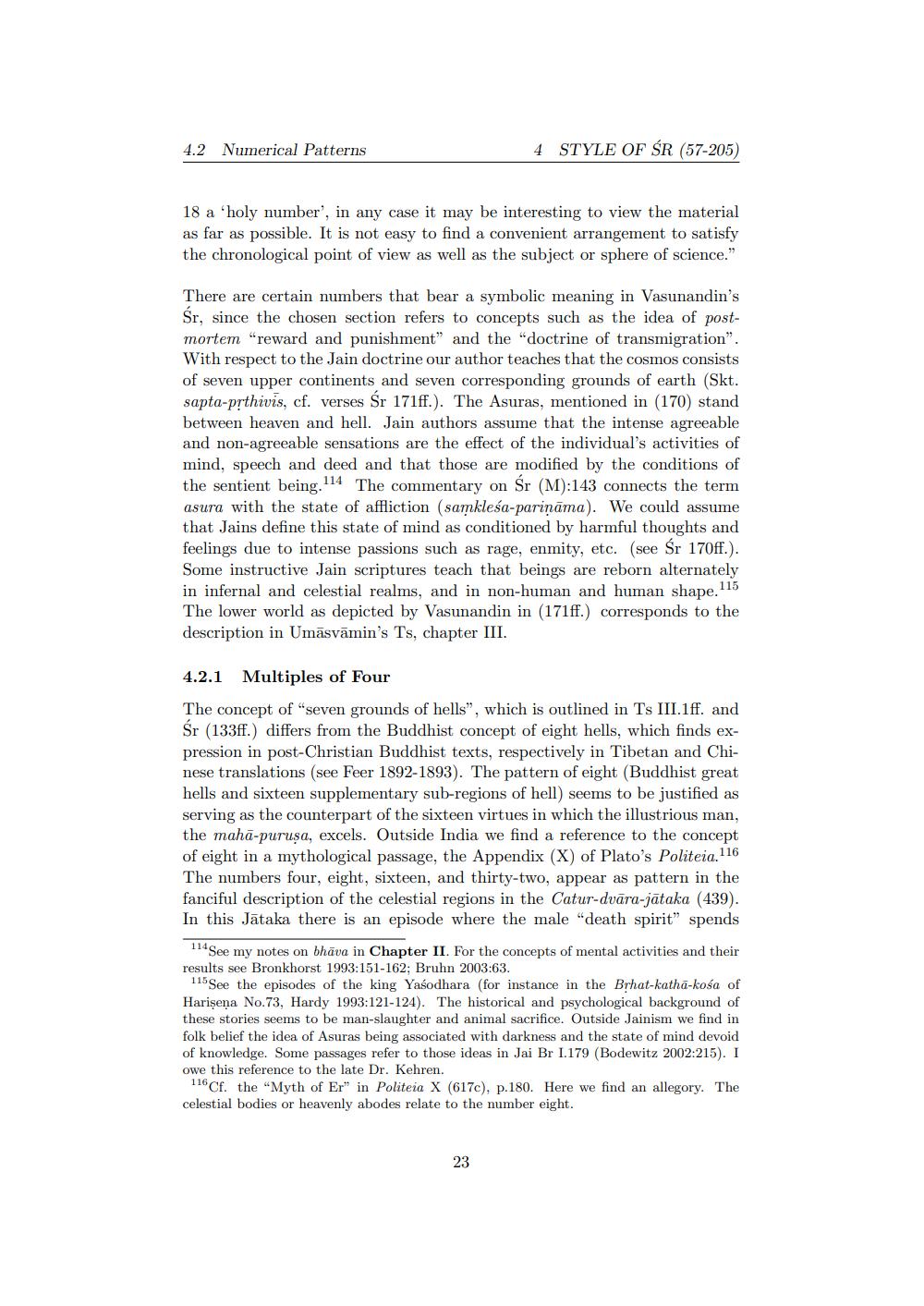________________
4.2 Numerical Patterns
4 STYLE OF ŚR (57-205)
18 a "holy number, in any case it may be interesting to view the material as far as possible. It is not easy to find a convenient arrangement to satisfy the chronological point of view as well as the subject or sphere of science."
There are certain numbers that bear a symbolic meaning in Vasunandin's Sr, since the chosen section refers to concepts such as the idea of postmortem "reward and punishment" and the "doctrine of transmigration". With respect to the Jain doctrine our author teaches that the cosmos consists of seven upper continents and seven corresponding grounds of earth (Skt. sapta-prthivis, cf. verses Sr 171ff.). The Asuras, mentioned in (170) stand between heaven and hell. Jain authors assume that the intense agreeable and non-agreeable sensations are the effect of the individual's activities of mind, speech and deed and that those are modified by the conditions of the sentient being. 114 The commentary on Sr (M):143 connects the term asura with the state of affliction (samklesa-pariņāma). We could assume that Jains define this state of mind as conditioned by harmful thoughts and feelings due to intense passions such as rage, enmity, etc. (see Śr 170ff.). Some instructive Jain scriptures teach that beings are reborn alternately in infernal and celestial realms, and in non-human and human shape. 115 The lower world as depicted by Vasunandin in (171ff.) corresponds to the description in Umāsvāmin's Ts, chapter III.
4.2.1 Multiples of Four
The concept of "seven grounds of hells", which is outlined in Ts III.1ff. and Sr (133ff.) differs from the Buddhist concept of eight hells, which finds expression in post-Christian Buddhist texts, respectively in Tibetan and Chinese translations (see Feer 1892-1893). The pattern of eight (Buddhist great hells and sixteen supplementary sub-regions of hell) seems to be justified as serving as the counterpart of the sixteen virtues in which the illustrious man, the mahā-purusa, excels. Outside India we find a reference to the concept of eight in a mythological passage, the Appendix (X) of Plato's Politeia. 116 The numbers four, eight, sixteen, and thirty-two, appear as pattern in the fanciful description of the celestial regions in the Catur-dvara-jataka (439). In this Jataka there is an episode where the male "death spirit" spends
114 See my notes on bhāva in Chapter II. For the concepts of mental activities and their results see Bronkhorst 1993:151-162; Bruhn 2003:63.
115 See the episodes of the king Yasodhara (for instance in the Brhat-katha-kośa of Harişena No.73, Hardy 1993:121-124). The historical and psychological background of these stories seems to be man-slaughter and animal sacrifice. Outside Jainism we find in folk belief the idea of Asuras being associated with darkness and the state of mind devoid of knowledge. Some passages refer to those ideas in Jai Br 1.179 (Bodewitz 2002:215). I owe this reference to the late Dr. Kehren.
116 Cf. the "Myth of Er" in Politeia X (617c), p.180. Here we find an allegory. The celestial bodies or heavenly abodes relate to the number eight.




